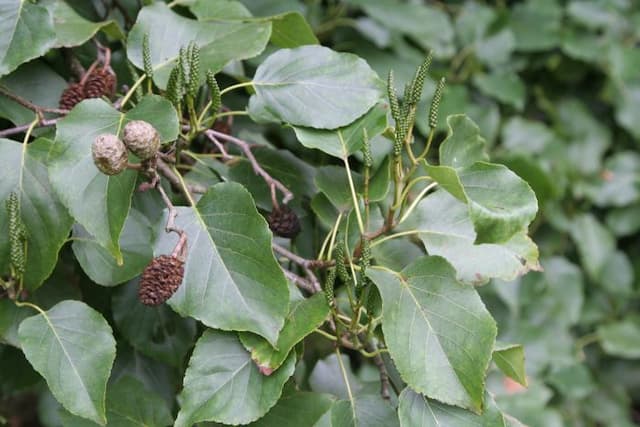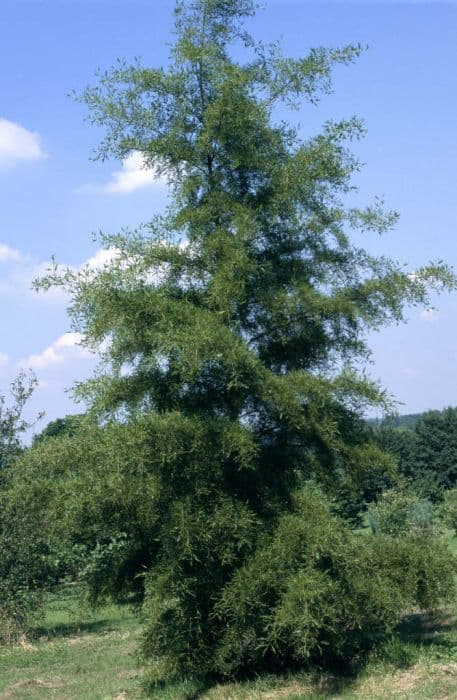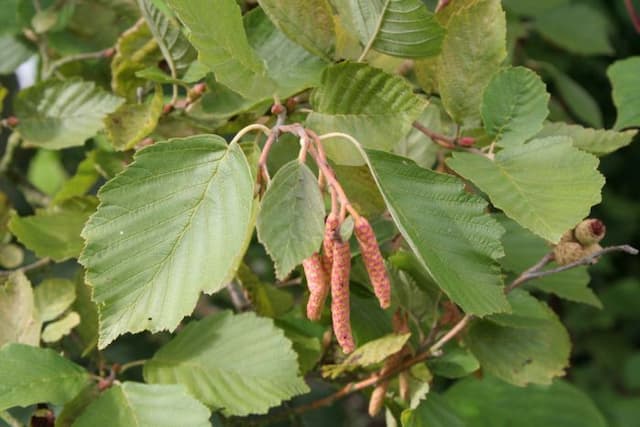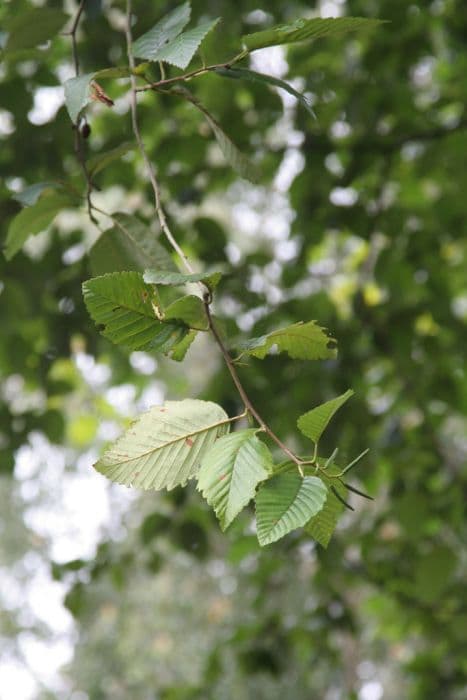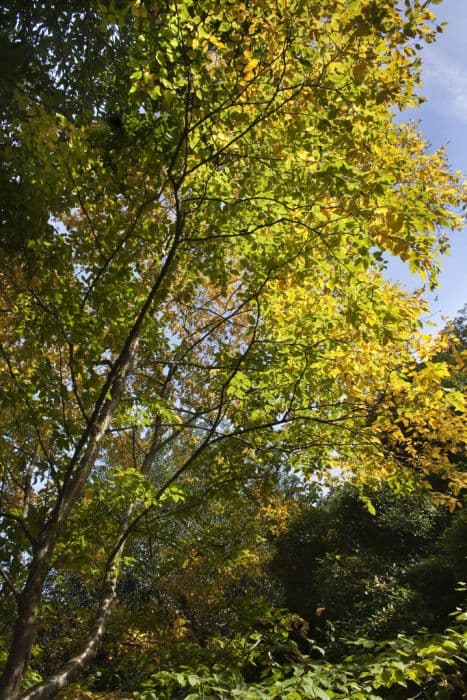Japanese cherry birch Betula grossa
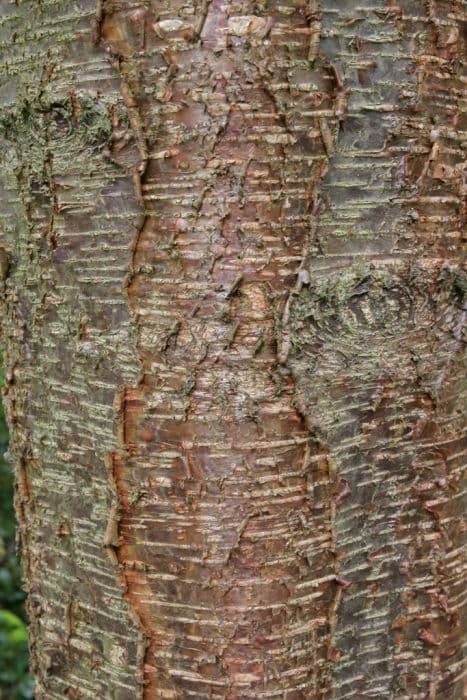
ABOUT
The plant commonly known as Japanese cherry birch is a striking decidoteous tree. It has a distinguished bark that peels off in horizontal strips, revealing a shiny and smooth underneath surface which can range in color from orange-brown to a reddish-brown, adding to its ornamental value. The leaves of the Japanese cherry birch are simple and alternately arranged on the branches, typically oval to lance-shaped with a pointed tip and finely toothed edges. They are notably glossy, with a dark green color on the top surface and a lighter shade beneath. During the blooming season, the Japanese cherry birch exhibits catkins, which are long, slender flower clusters. The male catkins are more prominent and pendulous, adding a touch of visual interest, while the female catkins are upright and less conspicuous. Following the flowering period, it produces small winged seeds that are dispersed by the wind, aiding in the proliferation of the species. The overall appearance is characterized by a graceful and elegant silhouette, with branches that may be upright or spread out, providing an aesthetic appeal through the seasons.
About this plant
 Names
NamesFamily
Betulaceae
Synonyms
Japanese Cherry Birch, Oriental Cherry Birch
Common names
Betula grossa.
 Toxicity
ToxicityTo humans
Betula grossa, commonly known as Japanese Cherry Birch, is not widely known for being toxic to humans. There are no commonly reported toxic effects from ingesting or coming into contact with the plant for individuals without specific allergies. As with many plants, individual allergies could result in reactions but this is not typical toxicity. If you suspect an allergic reaction or poisoning from any plant, seek medical assistance.
To pets
Japanese Cherry Birch is not widely recognized as a toxic plant to pets. It does not contain known toxins that commonly cause symptoms of poisoning in pets such as dogs and cats. However, as with any non-food plant material, ingestion can lead to gastrointestinal discomfort or an obstruction, particularly if large quantities are consumed. If you notice any unusual symptoms in your pet after ingestion of any plant, it is best to consult with a veterinarian.
 Characteristics
CharacteristicsLife cycle
Perennials
Foliage type
Deciduous
Color of leaves
Green
Height
50 feet (15 meters)
Spread
35 feet (10.6 meters)
Plant type
Tree
Hardiness zones
5
Native area
Japan
Benefits
 General Benefits
General Benefits- Landscape beautification: Betula grossa, also known as Japanese cherry birch, adds aesthetic value to landscapes with its attractive bark and foliage.
- Shade provision: The broad canopy offers ample shade during hot weather, making it a practical addition to parks and large gardens.
- Habitat for wildlife: It provides food and shelter for a range of wildlife, including birds and beneficial insects.
- Seasonal interest: Japanese cherry birch exhibits vibrant fall colors, adding seasonal interest to any setting.
- Erosion control: The root system can help stabilize soil and prevent erosion on slopes and banks.
- Wood production: The timber is valued for furniture, plywood, and veneer production due to its strength and workability.
 Medical Properties
Medical Properties- Antimicrobial: Betula grossa bark extract has demonstrated antimicrobial activity against certain bacteria.
- Anti-inflammatory: Compounds in the bark of Betula grossa might possess anti-inflammatory properties.
- Antioxidant: The plant may contain antioxidants that help in neutralizing harmful free radicals in the body.
 Air-purifying Qualities
Air-purifying QualitiesThis plant is not specifically known for air purifying qualities.
 Other Uses
Other Uses- Woodworking: Betula grossa, commonly known as Japanese cherry birch, provides a hard and durable wood suitable for furniture, flooring, and cabinetry.
- Ornamental Use: With its attractive bark and foliage, Japanese cherry birch is often planted in gardens and parks for aesthetic purposes.
- Craft Materials: The bark of Betula grossa can be used in craftwork, including the making of decorative items and jewelry.
- Dye Production: The bark and leaves of the Japanese cherry birch may be used to create natural dyes for fabrics and yarns.
- Water Filtration: The wood of Betula grossa can be used in charcoal form for filtering water and removing impurities.
- Food Flavoring: The sap of the Japanese cherry birch may be used as a flavoring agent in food products, similar to how birch sap is used in other regions.
- Instruments: The wood is sometimes used to make musical instruments due to its acoustic properties.
- Turnery: Betula grossa wood can be turned on a lathe to produce decorative objects or functional items such as bowls and spindles.
- Culinary Smoking: Wood chips from the Japanese cherry birch can be used for smoking food to impart a unique flavor.
- Beekeeping: The tree can provide a good source of pollen for bees, supporting local beekeeping practices.
Interesting Facts
 Feng Shui
Feng ShuiThe Japanese White Birch is not used in Feng Shui practice.
 Zodiac Sign Compitability
Zodiac Sign CompitabilityThe Japanese White Birch is not used in astrology practice.
 Plant Symbolism
Plant Symbolism- Growth and Renewal: Betula grossa, also known as Japanese Cherry Birch, embodies the concept of new beginnings and personal growth as birch trees are often among the first to colonize open grounds and can rapidly grow in such spaces.
- Adaptability: The Japanese Cherry Birch's ability to thrive in various climates signifies adaptability and resilience in the face of changing conditions.
- Purification: Birch trees have long been associated with purification and protection rituals, representing the cleansing of the old to make way for the new.
- Hope: The bright, peeling bark of the Japanese Cherry Birch stands out in a dark forest, symbolizing hope and light in dark times.
- New Beginnings: The Japanese Cherry Birch's association with the spring season, when birches release their seeds, resonates with the theme of starting afresh or embarking on a new journey.
- Beauty: Its ornamental nature and the beauty of its bark and leaves reflect the appreciation for beauty and aesthetics in different contexts.
 Water
WaterThe Japanese Birch should be watered regularly to maintain moist but not soggy soil, particularly during dry spells. Young trees benefit from watering once a week with about 1.5 to 2 gallons per event, gradually decreasing frequency as the tree matures. During periods of extended drought, it is crucial to water deeply every two weeks, providing up to 3 gallons to ensure that the moisture reaches the deeper roots. Overhead sprinkling can be used, allowing water to penetrate the root zone without causing runoff.
 Light
LightThe Japanese Birch thrives in full sun to partial shade conditions. It performs best when planted in a spot that receives at least 4-6 hours of direct sunlight daily but is also protected from the harsh afternoon sun. An ideal location would be one where it receives morning sunlight and afternoon shade or dappled light throughout the day.
 Temperature
TemperatureThe Japanese Birch can tolerate a wide temperature range but prefers temperate conditions. It survives in temperatures as low as -20°F and as high as 80°F, though the ideal temperature range for optimal growth is between 40°F and 70°F. It is important to protect the tree from extreme temperature fluctuations, especially sudden cold snaps after warm spells.
 Pruning
PruningPruning the Japanese Birch is important for removing dead or damaged branches, shaping the tree, and promoting healthy growth. The best time to prune is late fall to early winter when the tree is dormant. Prune no more than one-third of the tree's crown in a single season and focus on making clean cuts next to a bud or branch. Pruning should be done every 2-3 years to maintain the tree's structure and appearance.
 Cleaning
CleaningNot needed
 Soil
SoilJapanese Birch thrives in well-drained, slightly acidic to neutral soil with a pH of 5.0 to 7.5. A mix containing loam, sand, and peat ensures proper drainage and aeration. Amend with organic matter to enrich soil fertility.
 Repotting
RepottingJapanese Birch trees do not typically require frequent repotting. It's often planted outdoors where repotting isn't applicable. However, if grown in containers, repot every 3-5 years to refresh the soil.
 Humidity & Misting
Humidity & MistingJapanese Birch prefers moderate to high humidity levels typical of outdoor environments. While specific figures are not provided, ensuring the outdoor environment has natural humidity suffices for this tree.
 Suitable locations
Suitable locationsIndoor
Not ideal for indoor growth; requires large space, ample light.
Outdoor
Plant in well-draining soil, full sun to partial shade area.
Hardiness zone
4-7 USDA
 Life cycle
Life cycleBetula grossa, commonly known as Japanese Cherry Birch, begins its life cycle as a seed, typically dispersed by wind due to its lightweight and wing-like samara. Upon finding a suitable moist soil, the seed germinates in the spring, developing into a seedling with its first pair of true leaves after the initial cotyledons. As a sapling, the Japanese Cherry Birch rapidly grows, establishing a sturdy root system and beginning to exhibit the characteristics birch bark. Reaching maturity in several years, the tree begins to reproduce by producing catkins, which are the flowering structures; the male catkins release pollen, which fertilizes the female catkins. Once fertilized, the female catkins form seeds that are eventually dispersed, continuing the reproductive cycle. Throughout its life, which can span several decades, the Japanese Cherry Birch experiences seasonal changes, shedding leaves in the fall and entering a dormant phase in winter, only to leaf out again in the spring.
 Propogation
PropogationPropogation time
Late winter
Betula grossa, commonly known as Japanese Cherry Birch, is primarily propagated through seed sowing. The optimum time to propagate Cherry Birch by seeds is in the fall after seed maturity. Seeds should be collected and sown in a well-prepared seedbed or in pots containing a soil mix that provides good drainage. After sowing, cover the seeds with a light layer of soil, and ensure they receive consistent moisture until germination, which typically occurs in the spring. The delicate seedlings may then be carefully nurtured until they reach a size suitable for transplanting into their final growing location.
